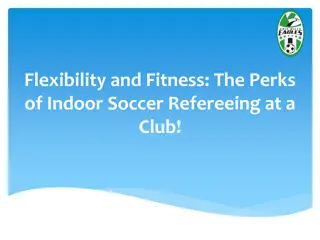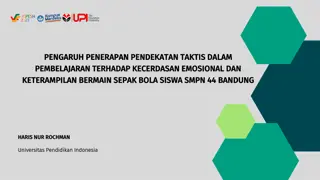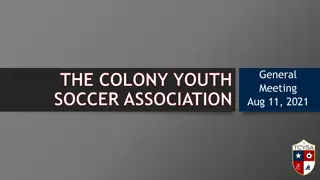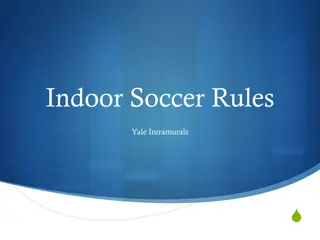Understanding and Applying DOGSO Rules in Soccer
Learn about the criteria for penalizing players who deny an obvious goal-scoring opportunity (DOGSO) in soccer. Explore factors like distance from the goal, direction of play, defenders' location, and more to make informed decisions. Discover how incidents within the penalty area are handled and when to award penalties or issue red cards.
Download Presentation

Please find below an Image/Link to download the presentation.
The content on the website is provided AS IS for your information and personal use only. It may not be sold, licensed, or shared on other websites without obtaining consent from the author. Download presentation by click this link. If you encounter any issues during the download, it is possible that the publisher has removed the file from their server.
E N D
Presentation Transcript
DOGSO Denial of an Obvious Goal Scoring Opportunity
Aim of this Session To identify and consistently apply the criteria for deciding when to correctly penalise a player for denying an obvious goal-scoring opportunity to an opponent
DOGSO Considerations What do you take into consideration when deciding when to penalise an offence that denies an obvious goal-scoring opportunity (DOGSO)? D D D C Distance between the offence and the goal General direction of the play * Location and number of defenders Likelihood of keeping or gaining control of the ball *If player moves diagonally to pass the last defender or goalkeeper, this can still be a DOGSO
General Direction of Play An attacker who was moving towards the goal but has had to take a momentary change in direction to avoid an opponent at the precise time he was fouled is still moving in the direction of the goal G D D D
The wider the angle of attack and the further away from the goal, the less OBVIOUS a Clear Goal Scoring Opportunity is denied High Possibility Low possibility
The Penalty Area When a defender denies an obvious goal-scoring opportunity inside the penalty area, there are some additional considerations Does the offending player attempt to play or challenge the opponent for the ball? Does the defender have no possibility to play the ball (in a fair manner)? Does the defender commit an offence that is not in a fair manner handling, holding, pushing, pulling?
The Penalty Area Where a player commits an DOGSO offence against an opponent within their own penalty area: Award a penalty kick Caution (YC) the offending player if the player unsuccessfully attempts to play or challenge an opponent for the ball In all other circumstances, (e.g. handball, holding, pulling pushing, no possibility to play the ball), the offending player must be sent off or The offence is punishable by a red card wherever it occurs on the field of play (e.g. serious foul play, violent conduct)
Outside the Penalty Area Where a player commits an offence against an opponent outside their own penalty area which denies an obvious goal scoring opportunity: The offence is always a red card unless
DOGSO - Advantage If the referee plays the advantage for an offence for which a caution/sending-off would have been issued had play been stopped: The caution/sending-off must be issued when the ball is next out of play If the offence was a DOGSO Red Card, the player is cautioned for unsporting behaviour when the ball is next out of play
DOGSO Quick Free Kick If the non-offending team takes a quick free kick, has a clear goal-scoring opportunity and the referee has not started the disciplinary sanction procedure: Allow play to continue At the next stoppage; the player is cautioned Explanation The quick free kick must restore a clear goal scoring opportunity If the referee allows a quick free kick after a DOGSO offence, the (delayed) Red Card becomes a Yellow Card
DOGSO Philosophy Does the offending player attempt to play or challenge the opponent for the ball? if the referee is unsure issue a yellow card rather than red card the player s movement towards the ball/opponent is a good indication of attempting to play or challenge the opponent for the ball
Match Incidents Group Exercise In your groups, Watch the clip and replays, you can do so as many times as you wish, apply the DOGSO principles, and select the bestoutcome:
Match Incidents Clip 3 Clip 4 Clip 1 Clip 2 Clip 5 Clip 6 Clip 7 Clip 8 Clip 9
General Advice DOGSO situations requires: an analysis of all the information and quick thought process the ability to freeze frame the incident (take a photo in your mind) at the moment the offence takes place as the picture can change very quickly correct judgement whether the offender, who is inside their own penalty area, attempts to play the ball or not the referee to be in a good and credible position with a good angle of view a positive reaction by the referee with clear positive body language clear communication with the referee team (where appropriate)
Summary Understand that the picture can change very quickly once the whistle is blown for the offence Ensure you apply the correct disciplinary sanctions Remember DDDC D D D C Distance between the offence and the goal General direction of the play Location and number of defenders Likelihood of keeping or gaining control of the ball























